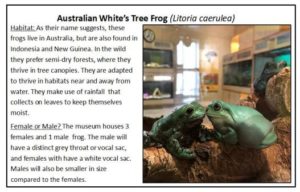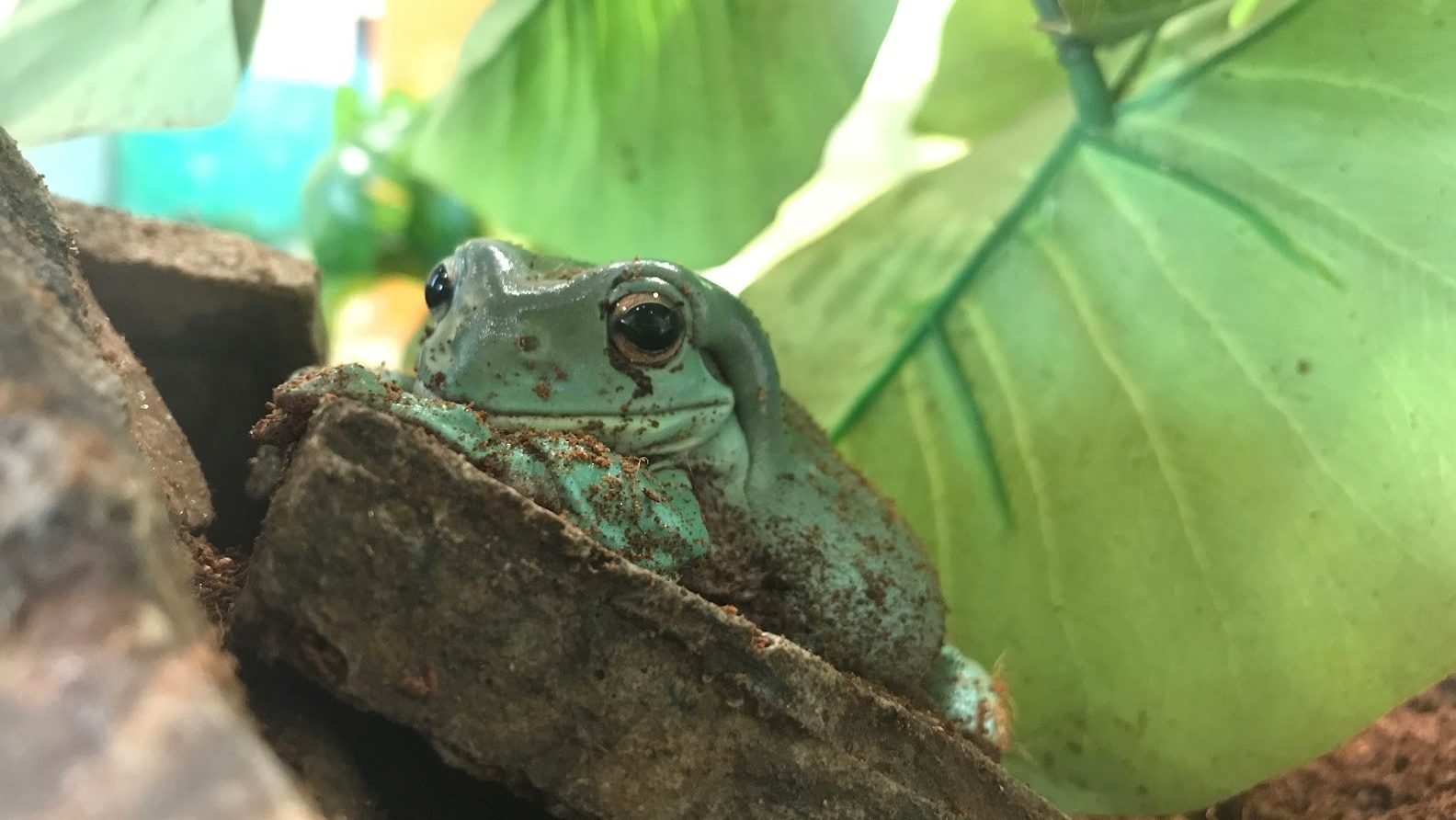Post written by Hannah Curtis, Education Assistant.
Daily Discovery: Meet the Amphibians!
Metamorphic, ectothermic, and ecological indicators! What kind of animal has these terms in common? That’s right, amphibians: toads, frogs, salamanders, and newts! Meet FCMoD’s amphibians, and become a herpetologist in your own backyard!
What are Amphibians?
Amphibians are characterized as ectothermic (cold-blooded) vertebrates. They require water or moist environments to survive and for laying eggs. The skin on amphibians is very thin and permeable, so liquids and gases are absorbed through their skin, allowing them to breath underwater! Some small frogs and salamanders don’t even have lungs and rely only on this adaptation to breathe through their skin!
Almost all amphibians go through the process of metamorphosis. Adult females lay their eggs and once the larvae hatch, they have gills and resemble fish. Through metamorphosis they grow four legs and air breathing lungs!
At FCMoD we care for a variety of amphibians. Check out a few of their individual life histories!


Threats from Water Pollution
Amphibians play an important role in their wild ecosystems, but they – and their water-based habitats – become threatened due to water toxicity and pollution. Because frogs, toads and salamanders spend most of their time in or around water environments, they will come into contact with any toxic chemicals in the water or abnormal rising temperatures.
Amphibians are like sponges! They absorb and breathe in whatever is in the water. Due to their easy susceptibility to unhealthy water conditions, they are a great indicator species for an ecosystem; they can be used to infer conditions in a particular habitat. If there is clean, fresh water, frogs and toads are going to be healthy. If there is trash, chemical waste like pesticides or oil spillage, or food processing waste in the water, the animals breathe in these bad, unhealthy things and are at high risk of dying.
You can help amphibians in the wild by remembering a few things:
- If you see a frog or toad, try not to touch it without gloves or clean hands (no hand sanitizer), as you could expose them to germs and chemicals.
- Always remember to dispose of your trash properly; if you see trash in a natural area or in a body of water, set an example for others in your community by cleaning it up!
- Buy and eat organic food. This reduces the use of harmful pesticides and insecticides that can leak into water sources, and don’t use pesticides on your own yard or garden.
- If you have a pet amphibian, protect them from noise and disturbance from other pets in your house.
- Share with others about what you learned about amphibians, and all the ways we can protect them!
- Remember that if you take care of the earth, the earth will take care of you and all the wildlife too!
Observations in the Backyard!
Whether it is in your backyard, neighborhood or at a Natural Area, animals can be observed just about anywhere! Herpetologists are scientists who study amphibians, as well as reptiles. They study and observe these animals in the wild to learn about their behaviors and identify their role within the ecosystem. Be a backyard herpetologist and observe animals similar to the museum’s amphibians and record what you discover!
Supplies:
- Writing utensil
- Paper
- Computer and internet access (optional)
Instructions:
- If you created an observational journal, write down your animal observations in the “explore your world” section. If not, create your own observational chart, using the provided guiding questions.
- Head out to your backyard or take a walk to a natural area with a water source to explore amphibians and their habitats.
- Check out FrogWatch USA to learn about the frogs and toads native to Colorado and listen to their unique croaks and calls!
Want to download these directions? Click here for a handy PDF!
Follow along with our Daily Discovery! Click here for all activities that you can do at home.
Traducido por Károl de Rueda y Laura Vilaret-Tuma.
Descubrimiento en casa: Conoce al animal – ¡los anfibios!
Son metamórficos, ectotérmicos e indicadores ecológicos. ¿Cuáles animales comparten estas características? ¡Los anfibios por supuesto! Estos incluyen sapos, ranas, salamandras y tritones. Conoce a los anfibios del Museo del Descubrimiento de Fort Collins (FCMoD) y ¡sé un herpetólogo en tu propio patio!
¿Qué son los anfibios?
Los anfibios son ectotérmicos y vertebrados. Esto significa que tienen sangre fría y una columna vertebral. Por resultado, necesitan vivir en el agua o en un ambiente húmedo para poder poner sus huevos y para sobrevivir. La piel de un anfibio es muy fina y permeable, por lo tanto, los líquidos y gases de su ambiente se absorben fácilmente a través de su piel. Esta peculiaridad les permite ¡respirar bajo el agua! La adaptación de “respirar” por medio de su piel ha logrado una evolución en algunas ranas y salamandras a tal grado, que algunas de ellas ¡no tienen pulmones!
Casi todos los anfibios experimentan el proceso de metamorfosis. Las hembras adultas ponen sus huevos en el agua y, cuando las larvas o los renacuajos salen del cascarón, estos nacen con branquias y parecen peces. Pero con el tiempo, y a través de la metamorfosis, ¡les nacen cuatro patas y dos pulmones que les ayudarán a respirar aire fresco!
En el museo, cuidamos a una variedad de anfibios.
La contaminación del agua y sus daños
Los anfibios poseen un rol importante en el ecosistema, pero ellos, al igual que sus ambientes acuáticos, son amenazados por la contaminación y la toxicidad del agua. Debido a que las ranas, salamandras, y los sapos pasan la mayor parte de su tiempo dentro o cerca de ambientes acuáticos, absorben los contaminantes en el agua o sufren con sus temperaturas anormalmente altas.
Los anfibios ¡son como esponjas! Absorben y respiran químicos presentes en el agua. Su susceptibilidad a condiciones insalubres sirve para ser una especie indicadora para el ecosistema. Los científicos usan esta clase de animales para determinar la condición de un hábitat particular. En agua fresca y limpia, las ranas o sapos vivirán sanos. Si hay basura, residuos químicos como pesticidas, derrame de petróleo, o desechos de residuos de alimentos, los animales respirarán estos contaminantes y estarán en alto riesgo de morir.
Tú puedes ayudar a los anfibios en la naturaleza simplemente recordando algunas cosas:
- Si ves alguna rana o un sapo, trata de no tocarlos con manos sucias o sin guantes. No uses desinfectante de manos, porque este puede exponerlos a gérmenes o químicos.
- Recuerda eliminar tu basura apropiadamente. Si ves basura en un área natural o en un cuerpo de agua, recógela y ¡sé un ejemplo para otros en tu comunidad!
- Trata de no usar pesticidas e insecticidas en tu jardín debido a que estos químicos pueden filtrarse en cuerpos de agua y dañar a los anfibios. Otra manera de ayudar es consumiendo comida orgánica.
- Si tienes una mascota anfibia, protégela de los ruidos o molestias de otras mascotas en tu casa.
- Comparte con los demás lo que has aprendido sobre los anfibios, incluyendo las maneras en las que los podemos proteger.
- Recuerda que si cuidamos a nuestro planeta, ¡el planeta nos cuidará a nosotros y a toda la vida salvaje!
Observaciones a tu alrededor
Los animales se pueden observar en un patio, en los jardines, en un área natural o en cualquier sitio. Los herpetólogos son científicos que estudian anfibios y reptiles, observándolos en su medio ambiente para aprender sobre sus comportamientos e identificarsu rol en el ecosistema. ¡Tú también puedes ser herpetólogo! Observa animales similares a los anfibios del museo ¡y documenta lo que descubres!
Artículos necesarios:
- Algo para escribir (lápiz, pluma o marcador)
- Papel y/o cuaderno
- Computadora y acceso al Internet (opcional)
Instrucciones:
- Crea una tabla de observaciones usando la guía de preguntas que puedes encontrar más abajo. Anótalas en un cuaderno, un diario o en hojas de papel.
- Da un paseo con tu familia por los alrededores donde haya algún cuerpo de agua (lago, río, etc.) y busca algunos anfibios. Observa sus comportamientos y medio ambiente. Si quieres aprender más sobre las ranas y sapos nativos de Colorado, haz clic en este enlace: FrogWatch USA ¡Ahí también puedes escuchar los sonidos que hacen
¿Te gustaría descargar esta actividad? Haz clic aquí para obtener un archivo PDF.
Para encontrar actividades, ideas y mucho más descubrimiento en casa, ¡síguenos!

